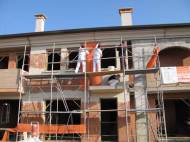Sisma Calce fabric is aiding in building integrity during earthquakes
 By now, it is likely that you’ve seen how devastating earthquakes can be. Thoughtfully planed construction and investment into better material and increased safety pay off for the damage and threatened lives. A group of researchers from the Karlsruhe Institute of Technology (KIT), Germany, have developed a reinforcing fabric that could be used to fasten debris that may fall down and obstruct the escape routes during an earthquake, as well as to increase safety of the crews sent to the location.
By now, it is likely that you’ve seen how devastating earthquakes can be. Thoughtfully planed construction and investment into better material and increased safety pay off for the damage and threatened lives. A group of researchers from the Karlsruhe Institute of Technology (KIT), Germany, have developed a reinforcing fabric that could be used to fasten debris that may fall down and obstruct the escape routes during an earthquake, as well as to increase safety of the crews sent to the location.
For several years, Lothar Stempniewski and Moritz Urban have investigated possibilities of low-cost retroactive securing and reinforcement of earthquake-prone walls of older buildings. They invented a glass fiber plastic fabric with four fiber directions. By means of an appropriate plaster, this special seismic fabric is applied onto the respective facings.
“Thanks to the reinforcement, collapsing of walls due to earthquakes can be delayed and, in the ideal case, be avoided completely. Particularly in the case of short and moderate earthquakes, mostly not much more additional tensile strength is needed to avoid a collapse of the building”, said Urban.
The high stiffness and considerable tensile strength of the glass fibers in the quasi plaster-integrated fabric allow walls to reduce high tensile stress which occurs during earthquakes, thus avoiding punctual damage occurs and creation of cracks. In case fibers do rupture after a strong earthquake, the researchers claim that elastic polypropylene fibers can hold the broken wall segments together and keep them off the escape routes. According to researchers, under advantageous conditions, the walls may even stay intact and houses could be repaired after the earthquake.
The stabilizing deformation behavior contributes to a better reduction of the energy introduced into the walls through the horizontal forces of the earthquake’s acceleration forces. The simplicity of the prophylactic dressing allows effortless integration during construction or renovation when insulation is being introduced.
Italian building material manufacturer Röfix, a subsidiary company of the German Fixit Group, has made this fabric commercially available under the Sisma Calce brand name, and they also sell a suggested type of plaster which is suitable for use along the fabric.
Aside being applied onto masonry walls, the team around Stempniewski intends to investigate potential solutions that could be applied for concrete buildings. KIT researchers are also cooperating with Bayer MaterialScience AG, MAPEI S.p.A., and Dr. Günther Kast GmbH & Co. KG, in order to develop an adhesive fabric that could be useful during seismic activities if it’s applied indoors.









Leave your response!